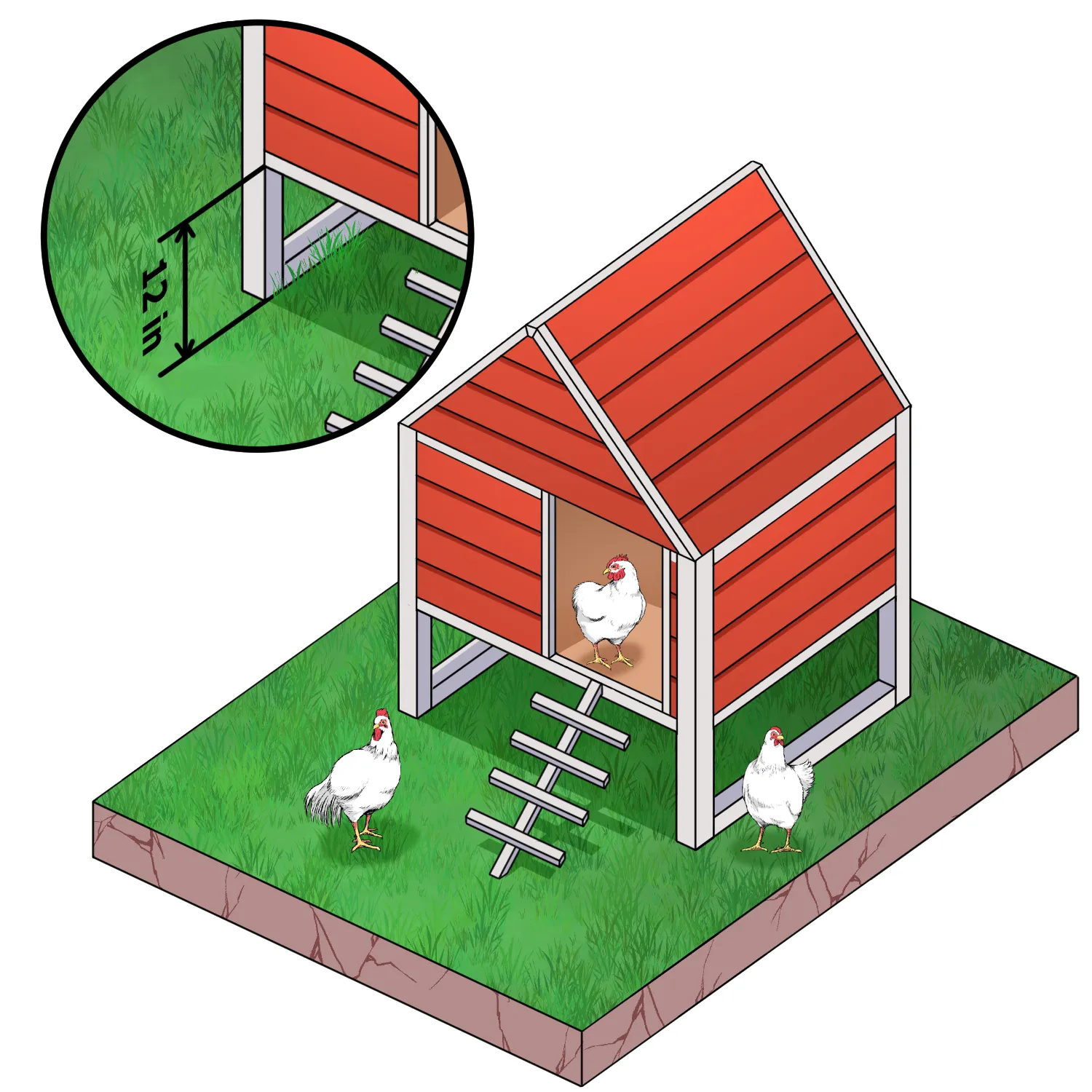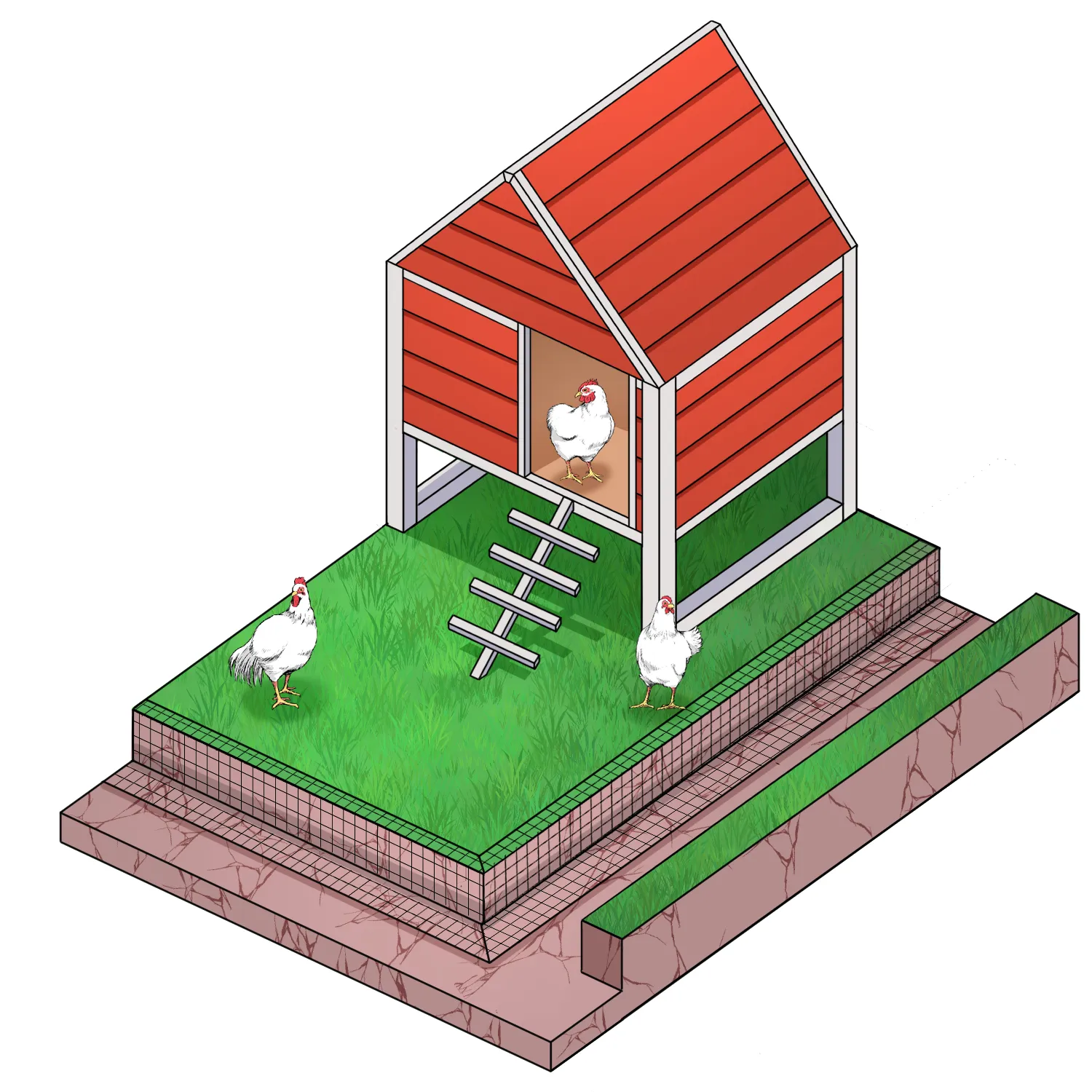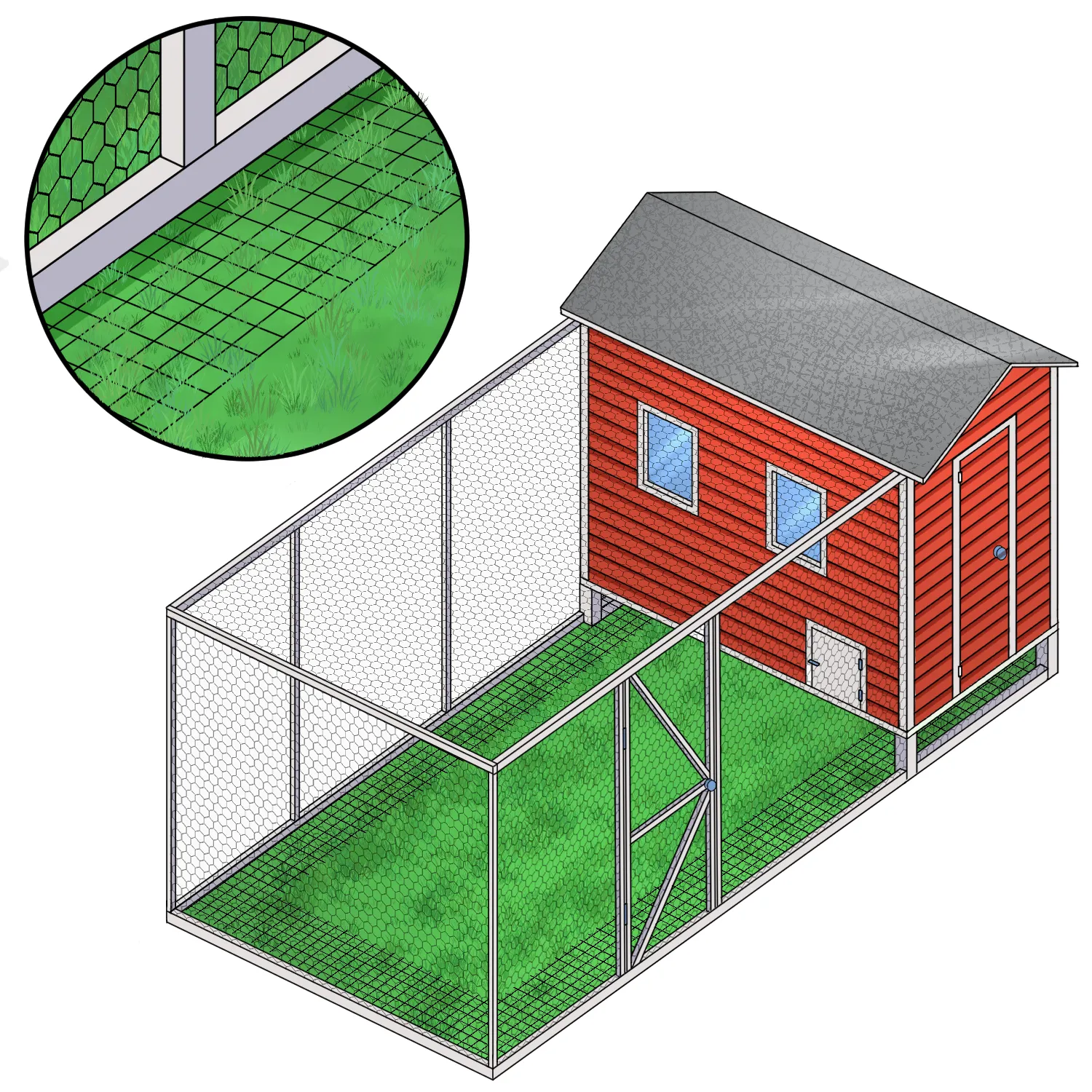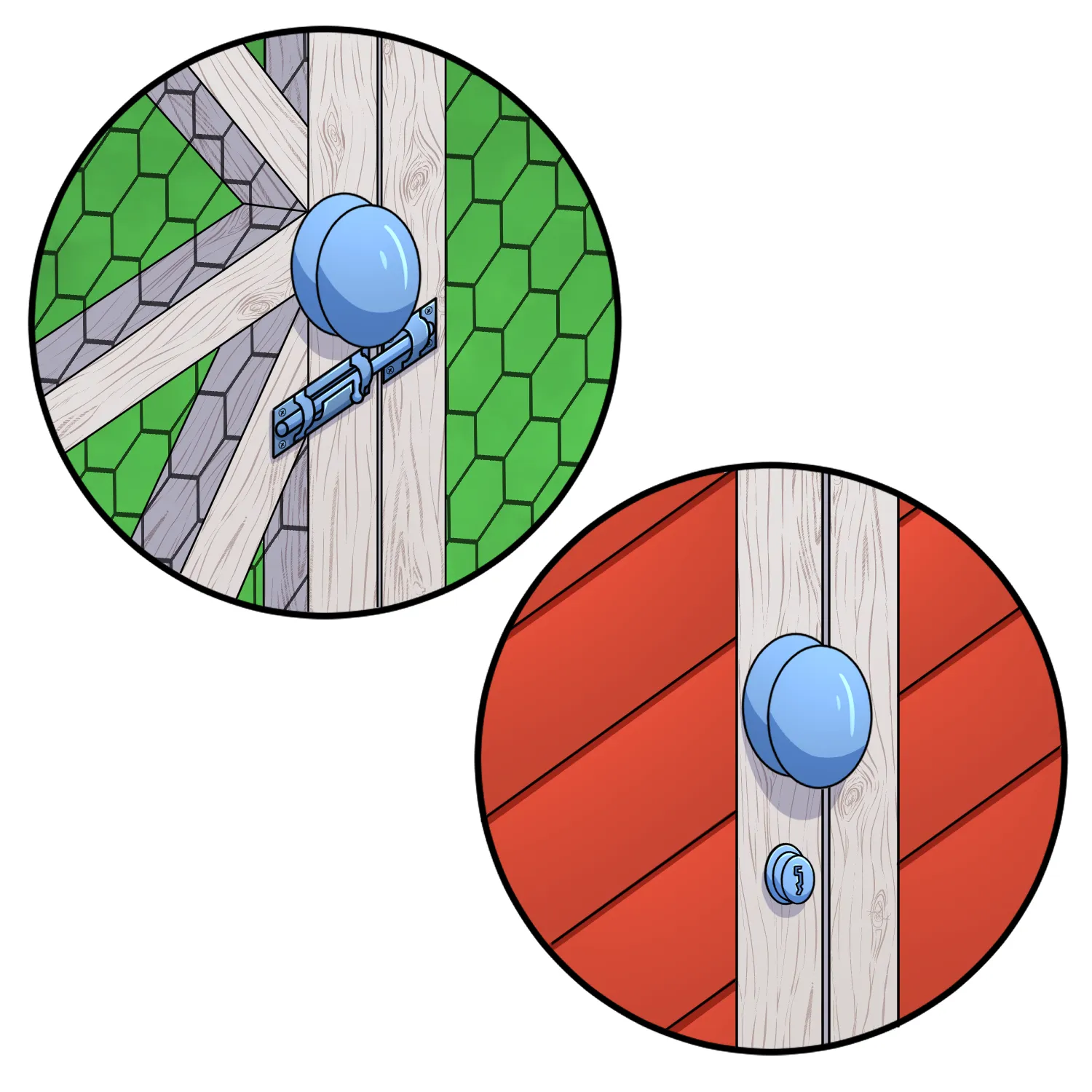Published on ; Last updated on ;
Chicken rearing can be a great hobby, but protecting your flock from predators can be challenging. This is especially true considering that both chicken and their eggs are prey for a wide range of predators. From hawks and eagles to land predators like raccoons, coyotes, foxes, bobcats, weasels’ skunks, snakes, and even neighbourhood dogs, chickens have many hungry enemies. Worse, it can take only one voracious predator to wipe out your entire flock. The best way to avoid the heartbreak of losing any of your beloved birds is to make your chicken coop predator-proof. Here are 10 ways and tips to secure your chicken coop and protect your flock against predators.
1. Elevate your chicken coop
Raising your chicken coop off the ground offers a host of worthwhile benefits. Besides naturally protecting your flock from burrowing animals, elevating your coop prevents moisture buildup and wood rot, which can create access points into the coop. Preventing moisture buildup also helps the wood last longer.
Ideally, you want to raise your coop at least 12 inches off the ground. The space underneath provides extra space for your chickens to roam and scratch while offering shelter from aerial predators, inclement weather, and the afternoon sun.

Notably, no matter how high you raise your coop, you will still need solid flooring to ensure predators that can take unorthodox approaches can’t break into the coop from underneath.
2. Use hardware cloth
While the chicken wire is a more economical choice for constructing chicken runs, it doesn’t stand up well against many predators. Simply, it is designed to keep chickens in, not predators out. That’s why you should consider hardware cloth wherever you would use chicken wire. This includes on windows, the run, and around the bottom of the coop.
Hardware cloth is rigid to deter raccoons and foxes and has small openings so hawks can’t reach chickens with their talons. The small openings also help keep snakes and members of the weasel family from burrowing and breaking into the coop or running.
3. Install a predator apron
Having a concrete or any other deterrent floor can keep predators from digging into the coop, but what about the run where your chickens spend their daytime? To outsmart sly predators like foxes, bobcats, and raccoons, install a predator apron around the perimeter of your chicken run: dig a 12-inch-deep trench around the coop and run, and then bury the hardware cloth in the ground.

This won’t stop cunny predators from digging, but it will keep them from getting into the run or coop. Because predators can’t see the buried hardware cloth, they will start to dig until they encounter the formidable barrier. Without the hardware-cloth apron, predators can possibly dig into the run and prey on your chickens or their eggs.
4. Fortifying the Run: Top to Bottom
Ensuring the security of your chickens encompasses safeguarding them from aerial as well as ground-based threats. Covering the run significantly mitigates the risk posed by these predators, whether you reside in urban or rural settings.
A covered run acts as a deterrent against flying and climbing predators like eagles, hawks, falcons, and owls. Utilizing a solid roof or a covering of hardware cloth is advocated for optimal protection. Budget-conscious poultry enthusiasts might opt for stringing netting across the top of the run, although it’s less effective against climbing predators capable of chewing through the netting.
In scenarios where the threat level is pronounced, amplifying the security measures is a logical step. For those managing small to medium chicken coops, enveloping the entire floor of the run with hardware cloth provides an additional tier of predator-proof protection. While this method may stretch your budget, it serves as a robust defense against the anguish associated with losing your birds to predators. For larger runs, a cost-effective alternative could be laying down hardware cloth a few feet around the inside perimeter of the run, instead of covering the entire floor, providing a substantial level of protection without incurring excessive expenses.
The amalgamation of covering both the top and the bottom of the run, perhaps coupled with a predator proof chicken coop, substantially enhances the safety of your flock, forming a fortified haven against the myriad of predators lurking around.

The idea is to fully protect your birds from predators, including the sly ones, which can take unconventional approaches. All in all, you should ONLY commit to covering the entire floor with hardware cloth if it is absolutely necessary.
5. Close the coop and run doors at dusk
Nocturnal predators can appear anytime after dusk and prey on your beloved feathered friends. To protect your flock from diurnal predators that might hunt until late evening and nocturnal predators that might begin hunting prematurely, close and lock the coop and run doors as soon as all your birds have entered their coop.
When you are away from home and not able to lock up the coop and run at dusk, take advantage of modern technology. There is no shortage of automatic coop doors that you can program to suit your needs.
Notably, even with an automatic coop door, it is imperative always to check your coop when back home to ensure all the birds are in and secured. An opossum can come in at dusk and deliberately hide in the run to wait to treat itself in the morning.
6. Eliminate food and things that attract wildlife to your chicken coop
The prime idea behind predator-proofing your chicken coop is to protect your flock against attacks. So, along with securing your coop, it is also crucial to avoid things that might attract predators to your coop.
One of the things that attract a variety of predators and pests to your coop is chicken feed. Finding a safe place outside the coop to keep the chicken feed at night can help minimize threats. Alternatively, you can use treadle feeders, which conceal the feed, lowering the temptation for rodents and other egg predators to come in.
If you’re fond of feeding your chickens treats, check and clean up any scraps your birds don’t eat.
7. Use guardian animals
To the surprise of many, pets can give your chicken much-needed protection. Geese, guineas, donkeys, llamas, some breeds of dogs, and even roosters have a reputation for being excellent flock guardians.
You can take advantage of these guardian animals to protect your flock. Roosters can sacrifice their own life battling a predator to protect their hens. On the other hand, a guardian dog will naturally spend time patrolling your property and bark at any predator that shows up to scare it away as it alerts you.
For chicken growers considering a guardian dog, Great Pyrenees, Maremmas, Anatolian Shepherds, and Akbash have excellent guarding instincts. You want to be cautious not to adopt a dog that will prey on your chickens instead of protecting them.
If you live in rural areas where livestock codes are relatively forgiving, you will have a wide range of options regarding what guardian animals you can keep.
8. Provide indoor roosts and train them to return to the coop before dusk
Chickens are more vulnerable when asleep. Thankfully, they instinctively sleep off the ground. Furnishing your chicken coop with enough roosting bars can ensure that your birds remain safe, even if predators make it into the coop. Besides, indoor roosts ensure your chickens are not tempted to roost outside, where they can be easy prey.
Even with roosts, you will want to train your chickens to retreat into the coop as the daylight fades, as a number of predators are usually active at this time. And as with training other pets, training chickens is based on a reward system. Reward your birds with feed or treats in the evening to encourage them to return to the coop some minutes before nightfall. It won’t take long before they learn to flock to their home at dusk.
9. Use secure door latches and two-step locks
Some predators, like raccoons, are intelligent and adept at opening latches and simple locks. Yes, they have mastered how latches work.

To deter a determined raccoon, use a lock that requires opposable thumbs to open. Such locks will prove bothersome, leaving predators with the option to leave.
10. Use predator deterrent accessories
Besides making your chicken coop predator-proof, you can tap on the benefits of deterrents like lights with a motion sensor, electric chicken fencing, and decoy animals.
Although the effectiveness of these deterrents varies, combining them with proven methods can ensure you don’t lose any of your birds to predators.
Conclusions
If you have been into the chicken-rearing hobby for an extended period, you already know how heartbreaking it is to lose any of your birds to predators.
Whether you are an aspiring chicken grower or a seasoned pro, knowing how to predator-proof your chicken coop is vital in ensuring your flock remains safe and happy. Before considering any specific breed and bringing birds home, consider these predator-proofing practices for optimal safety. Otherwise, your first flock might turn into a snack for a predator.
Minor weaknesses can quickly mature into a significant threat, so remember to periodically inspect your coop and run to ensure there haven’t been breaches.
